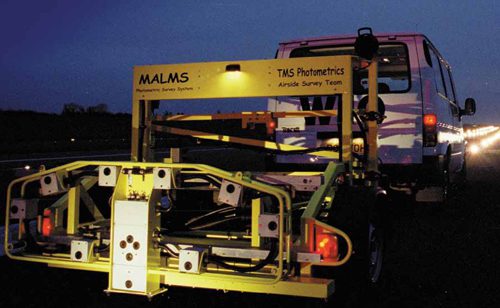
|
factsfigures Project: Testing Runway Lights Location: San Diego Int’l Airport Equipment: Mobile Airfield Light Monitoring System from TMS Photometrics Benefits: Improved runway visibility for pilots; assurance that lights meet FAA requirements; reduced maintenance costs associated with replacing only defective lamps |
The Mobile Airfield Light Monitoring System (MALMS), by British company TMS Photometrics, allows crews to measure the brightness of individual lighting fixtures at speeds up to 50 mph, say company officials.
After the trailer and equipment are readied, it takes about 21/2 hours per runway to test and maintain the lights, reports Christopher Rose, lead electrician SAN. “We test the edge lights first and then move the sensors into a different position to test the center line lights and touchdown zone lights,” Rose explains.
 Robert Shapton, CEO of TMS Photometrics’ parent company, Tailor Made Systems, notes that the equipment is ideal for busy airports. Because it only takes five minutes to test one direction of an entire runway centerline at 50 mph, he notes, the equipment can be used in between flight operations. With the system pinpointing the exact location of faulty fixtures, technicians can zero in on a fixture and replace it within minutes before the next flight takes off or lands, he adds.
Robert Shapton, CEO of TMS Photometrics’ parent company, Tailor Made Systems, notes that the equipment is ideal for busy airports. Because it only takes five minutes to test one direction of an entire runway centerline at 50 mph, he notes, the equipment can be used in between flight operations. With the system pinpointing the exact location of faulty fixtures, technicians can zero in on a fixture and replace it within minutes before the next flight takes off or lands, he adds.
The ability to complete all testing and replace faulty fixtures in a single night is important at SAN, where there is only one active runway, and it only allows departures from 11:30 p.m. to 6:30 a.m.
|
With only one active runway at San Diego Int’l, it’s vital to complete all testing and replace faulty light fixtures in a single night |
“To me, the system is extremely effective and a much more efficient way to maintain lighting,” says Rose. “I’ve been at the airport eight years, and this is one of the biggest benefits we have implemented.”
MALMS equipment helps airports reduce maintenance costs by enabling airfield electricians to replace or repair only fixtures that require maintenance and pinpointing problem fixtures before they fail, explains Shapton.
“The most extraordinary thing to me is that people don’t understand the need to test the performance of runway lights,” he notes. “If they could see the lights from the eyes of pilots trying to land a plane at night, they would pay more attention to the problem.”
 Prior to the development of photometric testing equipment, airports had no way to accurately assess whether lights were performing at required intensity levels, Shapton recalls. As a result, some technicians would perform unreliable visual inspections to determine which lights appeared dull or completely dark, chronicles David Rainey, Tailor Made Systems’ North American representative. Others, he adds, would take an inefficient and expensive approach to maintenance: replacing all lamps, whether they needed replacing or not.
Prior to the development of photometric testing equipment, airports had no way to accurately assess whether lights were performing at required intensity levels, Shapton recalls. As a result, some technicians would perform unreliable visual inspections to determine which lights appeared dull or completely dark, chronicles David Rainey, Tailor Made Systems’ North American representative. Others, he adds, would take an inefficient and expensive approach to maintenance: replacing all lamps, whether they needed replacing or not.
“It can cost up to $75,000 per runway for bulk replacements of lamps,” emphasizes Rainey. “Airports that adopt this approach assume that if the estimated life of a runway lamp is X hundred hours, then the lamps will need to be changed every 18 to 24 months anyway. But, if airports change the lamps too often, they are throwing away perfectly good lamps. If they do it too late, most of the fixtures have already deteriorated beyond the required standard.”
The best way to do it, says Rainey, is to test lights monthly and replace or clean only those that aren’t working properly.
MALMS equipment can also help determine the effectiveness of new lighting installation, he adds. Simply driving the equipment over the lights allows electricians to ensure the lights are aligned properly and burning at the proper intensity, he explains.
“Fundamentally, there is no other way to ensure lighting is performing to specifications,” says Shapton. “There is an attitude across a large community of airfield lighting people that if lights are on, they must be working.”
All the lights may appear to be working when viewed by a technician standing on the runway, he cautions, but some will start disappearing when viewed from farther away. “Add fog, driving rain, sleet or snow to the mix, and you have a very serious potential safety risk,” he warns.
The company posted a video at http://www.youtube.com/watch?v=R4b9hI3nfN4 to demonstrate what improperly illuminated lights look like to pilots.
Birmingham Airport in England uses MALMS equipment to test its centerline runway lights once a week and takes all unserviceable lights in for maintenance that week, reports Rainey. Refurbished fixtures are stored on a maintenance truck so they are readily available to replace faulty fixtures. In the past eight years of using the equipment, the airport has not had one “outage” on the runway, he notes.
According to TMS, more than 200 airports worldwide use MALMS equipment.
A Bright New Start
 When SAN replaced fully 70% of its runway light fixtures with new LEDs last year, the cost to acquire MALMS testing equipment was rolled into the project budget.
When SAN replaced fully 70% of its runway light fixtures with new LEDs last year, the cost to acquire MALMS testing equipment was rolled into the project budget.
“Having the equipment definitely saves a lot of time,” reports Rose. “We spent a little more money to buy the testing equipment, but we don’t have to replace lights nearly as often; so it pretty much paid for itself.”
In addition, he’s far more confident that lights are working properly. “To the human eye, we thought the light being produced was bright enough,” he explains. “But we learned that wasn’t always the case.”
According to Rainey, there are a number of likely causes: Chemicals such as deicing fluid can reduce the output, and even water spots can decrease performance. With in-pavement fixtures, rubber buildup on the lens is often the culprit. The most common problem with high-intensity edge lighting, he adds, is skewing that misaligns the lens and lamp.
“When people on the ground look at it, they see it as an omni-directional light source,” explains Rainey. “But, in fact, the light has optics built into it that put out two clearly defined beams. Those beams are toed in toward the centerline at 3.5° and vertically at 4°. They are aimed directly at the pilot on his final approach.”
| “Airports have a duty to give pilots the best visual clues they can at the moment the pilots need them.” Robert
Shapton, Tailor Made Systems |
AC Aid
Ensuring that runway lights are performing up to standard helps airports comply with FAA Advisory Circular 150/5340-26B, Maintenance of Airport Visual Aid Facilities, which requires light output to be aligned in the proper direction and equal to or greater than 70% of the required design output of the light fixture when it is new.
That means a Category I/II/III airport with centerline lights with a minimum design value of 5,000-candela output must emit a minimum of 3,500 candelas, with a minimum of 95% of the lights in the system being above the 70% serviceability level, says Shapton.
During testing, he notes, MALMS equipment can determine what color a light is emitting. Red runway centerline lights, for instance, are only required to put out 750-candela power. Because red lights are installed in specific locations on the airfield, Shapton explains, the software automatically adjusts to the lower intensity requirements for red or other colored light fittings and doesn’t falsely flag low output.
According to Rainey, lighting output performance requirements were not necessarily viewed as mandatory in the past; but the latest advisory circular clarifies that all airports that install lighting systems using Airport Improvement Program funds or passenger facility charges are required to follow the methodology and maintenance tolerances listed in the circular.
The International Civil Aviation Organization threshold is 50% of the lights’ required design value.
How it Works
According to Rose, test preparation takes about 35 minutes: five minutes to hook the equipment trailer to a tow vehicle, 15 minutes to launch the correct program on the laptop and 15 minutes to ensure that the sensors are in place and ready to go. After the prep, a technician simply drives down the runway. The equipment automatically tests the selected system – centerline lights, edge lights or touch zone lights – at speeds up to 50 mph without loss of accuracy, notes Rainey.
“The built-in GPS records the location of each light as the driver passes over it. When the operator gets to the end of the runway, he pulls up a color-coded bar chart that indicates the location of problem lights or lamps that are about to fail,” he explains.
“The display shows the light output and the location of the fixture as well as an arrow pointing to where it is and the distance needed to travel to find the lamp,” Rainey continues. “In fact, it’s sophisticated enough to beep on arrival. All the technician needs to do is get out of the truck to investigate what’s wrong. It could be the fixture needs to be cleaned or realigned. Perhaps the lamp needs to be changed. If necessary, the entire fixture can be brought into the shop for refurbishing.”
Rainey learned about photometric technology while working as the airfield electrical supervisor at Memphis International Airport. When the facility lengthened its center runway to 12,000 feet, TMS was hired to ensure that the new installation was functioning properly and within FAA standards.
“I was so impressed with how the equipment operated – its capabilities, accuracy and ability to quickly and easily repeat a test – that I kept in touch with the company after I retired in 2001 and offered to promote the system as part of the testing and training services offered by Navaid Lighting Associates,” comments Rainey. “It is extremely well-engineered, easy-to-use, and the system won’t allow the user to conduct an incorrect test. The system won’t even start the procedure until the equipment is set up properly and the correct program is selected.
“Because of the built-in GPS, the system knows where you are and whether or not you are in the right position to conduct a test,” he explains. “For example, all the technician has to do is tell the system to test centerline lights on Runway 18L, allow it a few seconds to perform a diagnostic test to make sure it’s set up properly and then start rolling down the runway. If the sensors are positioned incorrectly for the test the technician wants to run, it won’t allow the test to begin and will explain what’s wrong. It will even advise the operator how well he drove at the end of the run and give him the option of recording or discarding the data.”
According to Rainey, technicians only need a few minutes of training to learn how to operate the system. Computer-savvy skills, he adds, are not needed.
Low Doesn’t Mean No
|
Engineer Society Lauds LED Conversion San Diego International Airport will be recognized by the American Society of Civil Engineers (ASCE) in May for its work installing new airfield signs, taxiway lights and runway guard lights. ASCE will present the airport with an Outstanding Award in Sustainable Technology as part of its civil engineering project awards program. Representatives from Kimley-Horn and Associates will join airport staff in accepting the award. The project involved replacing 20-year-old incandescent elevated taxiway edge lights as well as taxiway and runway signs with energy-efficient LED fixtures. The new lamps are expected to greatly reduce power consumption, says Kimley-Horn engineer Mike Ross. “Even though the airport incurred a cost to put in the new lights and replace old conduit and cabling, it will only take a few years for the airport to see a return on its investment,” notes Ross.
The project also involved the first U.S. installation of FAA-approved LED runway signs throughout an entire airport. During the same project, the airport installed runway guard lights that flash a warning to pilots approaching an active runway. The new lights provide another visual cue to pilots about where to stop. The additional device, Ross notes, can be especially helpful if pilots have trouble hearing the tower or misunderstand the instructions they receive. “The goal is to reduce incursions at taxiway intersections to the runway by making the hold position more visible,” he explains. “All airports use striped lines to indicate runway hold positions, but they can be hard to see in the rain. When the guard lights are flashing, pilots know to pull up and wait for the OK to cross the runway.” The ASCE award recognizes the project’s significance in improving airport safety and decreasing energy use – both hallmarks of sustainable technology in Ross’ book. |
“LEDs do last much longer, but the inset lights are still subject to accumulating rubber, dirt and other contaminants,” Rainey cautions. “Even with LED lights, output decreases over time with age. LEDs get dimmer over time just like any other lamp.”
SAN uses a MALMS Photobench to ensure that lights are delivering the required output after technicians change lamps and clean defective units. The computer displays light performance in both directions and advises if the unit passed or failed.
“That’s a useful feature, because technicians can know for sure the lights are fully serviceable before they are put back in the field,” Rainey notes.
Photobench includes a computer-controlled turntable with an array of light sensors at the end of a tunnel. Because the tunnel eliminates the need for a special dark room, most airports locate the equipment in the electrical workshop.
Later this year, TMS plans to introduce a cleaning machine that will be guided by the GPS coordinates produced during MALMS testing. According to Rainey, the machine will automatically stop at each problem light and use a biodegradable dry powder to clean the fixture without scratching the lens; the operator won’t even have to leave the vehicle.
Maintaining Effectiveness
Poor runway lighting can cause problems for pilots and air traffic control alike. The runway visual range (RVR) calculations pilots use to determine if it is safe to take off or land, notes Shapton, presuppose that runway lights are working correctly to specifications. If pilots operating in poor visibility conditions are further hampered by ineffective lighting, he relates, the airport might have to space aircraft out over greater distances or close a runway completely, he explains.
The whole point of maintaining proper airport lighting is to help pilots and increase safety. “Airports have a duty to give pilots the best visual cues they can at the moment pilots need them,” insists Shapton. “When airport operators are able to maximize capacity and safe operation by keeping on top of maintenance, then they see less unplanned maintenance or runway closures.”
Airlines, he adds, rely on airports to minimize delays and help provide maximum customer satisfaction.
Proper maintenance is also of interest to regulators. While it is unlikely that an FAA inspector will go out on the field to test random light fixtures, Shapton says that showing inspectors reports with specific replacement dates and light output for each bulb goes a long way toward demonstrating compliance with the regulations.
The application of MALMS equipment also relates well to the implementation of FAA-required safety management systems policies, adds Rainey.
Shapton says that because photometric testing equipment is now readily available, the FAA will require its use if an airport receives federal funding.
As a result, Tailor Made Systems plans to begin manufacturing MALMS equipment in the United States.
“We feel if public money is going to be spent on photometric testing as a result of federal rules, building the equipment needs to create American jobs,” explains Shapton. “It is pointless to build trailers that include a lot of steel which must be imported to England, only to have the finished product shipped back to America.”


